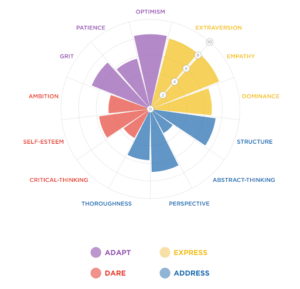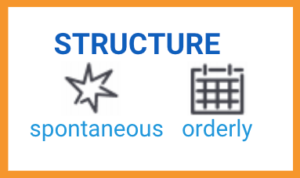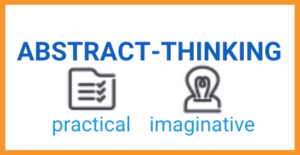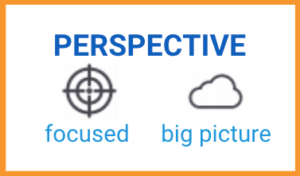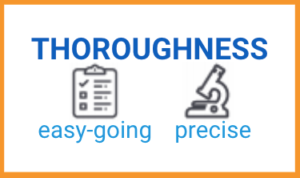Even if you think that you know a lot about yourself and your personality, it is always good to be open to an unbiased opinion about how you respond to the world around you. This can include how you interact with others in class or during meetings, the way you handle pressure of deadlines or tests, and how you organize projects. Taking a personality or soft skills assessment, like MyPrint, can help to uncover strengths you were unaware of or reinforce what you already knew.
What are your strengths and how do you use them on a daily basis? Are there any skills that you are missing or want to improve upon? These are just a couple of the questions that you can ask yourself to get the most out of your soft skills assessment results.
Understand how you approach tasks and projects.
Personality and soft skill assessments help us understand ourselves better by using basic psychological models, such as the Big Five Model of personality. At Talentoday, we have organized our personality dimensions into four groups, called the personality axes, to show how understanding your different traits will empower you to navigate your day-to-day life using science and technology. The four personality axes in MyPrint help us understand how we interact with other people (“Express” – yellow), our tasks and projects (“Address” – blue), ourselves (“Dare” – red), and our environment (“Adapt” – purple).
The Address section of the personality axes is helpful for understanding the way someone approaches issues and undertakes their tasks or projects. This can be beneficial when starting a fresh school year or new job, or if you’re just generally interested in making meaningful improvements in your day-to-day responsibilities.
The four personality dimensions that make up the Address axis are: Structure, Abstract-Thinking, Perspective, and Thoroughness. Being on the high or low end of each of these dimensions does not make you better or worse at planning or conducting your tasks; rather, it helps you to understand your strength in each of those areas so that you can lean into the things you are good at, while pinpointing the areas in which you may want to improve. Remember, you can always leverage an assessment to help understand your personality with an unbiased, scientific approach.
Structure
The two ends of the structure dimension are Spontaneous and Orderly.
If you are a spontaneous person, then you are naturally intuitive. You like to stay flexible in your schedule by avoiding planning things too far in advance, and you often leave a lot of room for improvisation in your working methods. If you are finding that you need a little bit more structure when organizing your week, start by writing down your most important objectives, and do your best to accomplish those even if other things come your way.
On the other end of the structure dimension are the orderly people. If you are orderly, then you are very organized and show no tolerance of ambiguity in your work. You always plan your tasks and projects well in advance and rarely deviate from your schedule. Although this may seem like it is the best way to organize and plan, there are certain times when flexibility is beneficial. When creating your to-do list, determine what is an absolute priority and what you can be flexible with; stay open to opportunities that may come your way.
Abstract-Thinking
The two ends of the abstract-thinking dimension are Practical and Imaginative.
If you are a practical person, you are realistic and don’t like to waste too much time wondering why things are the way they are. You rely on concrete examples to solve issues. If you find yourself stuck when working on an assignment, try to tap into your imagination a little bit. Think of some out-of-the-box ideas for your projects that you might not normally entertain.
On the other end of the abstract-thinking dimension are the imaginative people. If you are imaginative, you often conceptualize problems and try different approaches in order to solve them in the most relevant, but not always the most realistic way. Imaginative people are very creative, but if you find yourself unable to solve an issue, try to only look at what resources and solutions that you actually have available.
Perspective
The two ends of the perspective dimension are Focused and Big Picture.
If you are a focused person, then you are action-oriented. You probably prefer to concentrate on achieving short-term results, rather than spending time to anticipate their future implications. While it is beneficial to focus on those immediate outcomes, there is also a lot to be learned when looking at the long-term impacts of what you are doing. When learning something new or working on a project, think about the relevance and meaning it will have a few years into the future.
The other end of the perspective scale is where the big picture thinkers are. If you are big pictured, you are naturally thoughtful in your work. You will anticipate the long-term consequences of what you are doing as much as possible to have a clear vision of the final outcomes. At times it can be exhausting to think about the future when there is so much uncertainty. If you find yourself being overwhelmed by this, try to focus on the pieces of a project that you can immediately impact regardless of their long-term implications.
Thoroughness
The two ends of the thoroughness dimension are Easy-Going and Precise.
If you are an easy-going person, you are typically tolerant of imperfections. You prefer to value your productivity at work by focusing on the bottom-line, rather than dwelling on every little detail. Having a quantity-centered approach to your work can be beneficial at times, but it is always good to be cognizant of which projects might require a little more attention to detail. When these types of projects come up, schedule some extra review time into the end of your day!
On the other end of the thoroughness dimension we have the precise folks. If you are a precise person, you are naturally diligent. You set high-quality standards for your work and spend time to refine it. However, sometimes it is hard to turn off the ‘perfectionist’ switch. Determine which areas of your work need the extra attention to details, and try to only spend the necessary time on the rest.
Putting it all into action.
Now that you know a little more about the personality traits used to understand how you take on tasks and projects, as part of MyPrint’s Address dimension, it is time for you to take action. If you haven’t taken a MyPrint just yet, you can take it for free in just 25 minutes! There are many other helpful insights besides the ones we discussed here, such as what motivates you, or getting a better understanding of your professional behaviors. Take a look at which soft skill strengths you have and what motivates you, and use that information to help you improve as you take on your next project!



